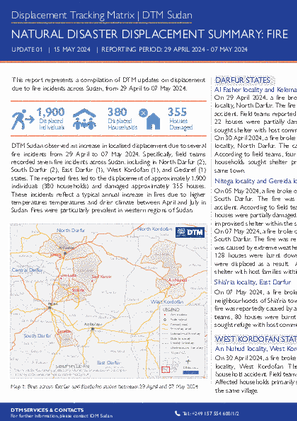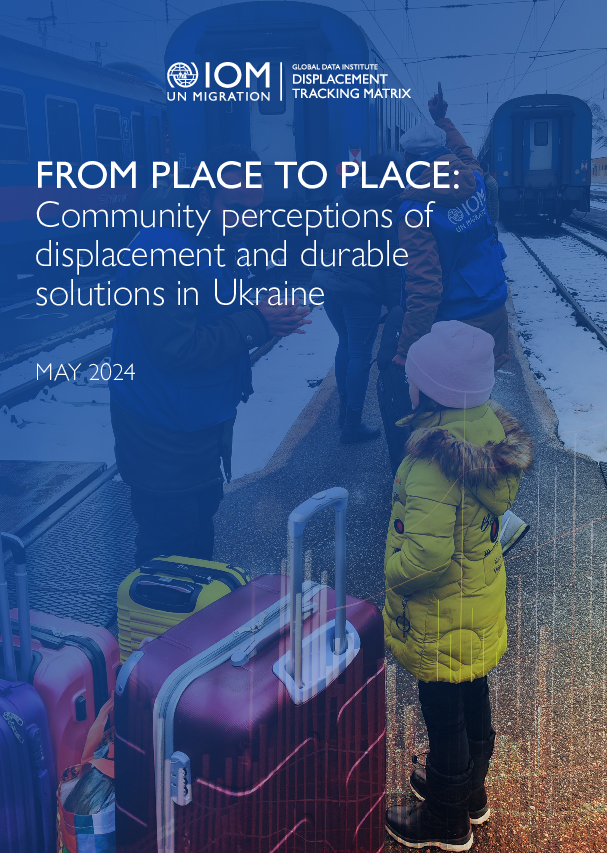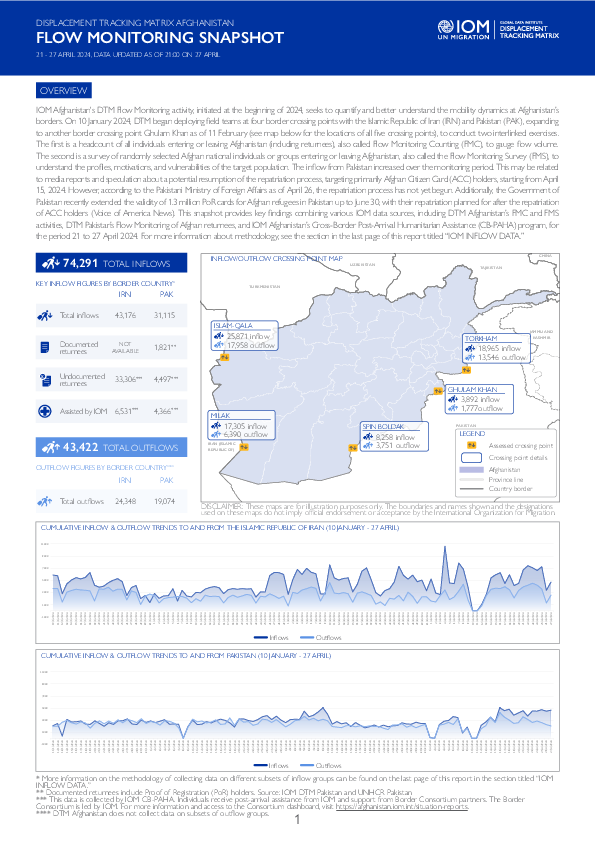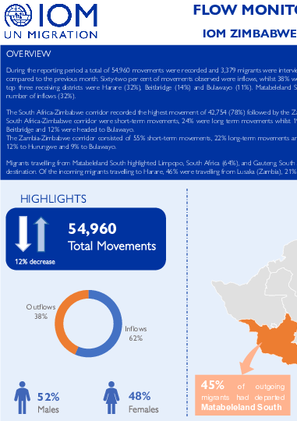-
Countries
-
Data and Analysis
-
Special Focus
-
Crisis Responses
Compilation/Overview
Color
white
This snapshot on nationals from Pakistan in Europe is part of the outputs of IOM’s EU-funded Displacement Tracking Matrix - Regional Evidence for Migration Analysis and Policy (DTM REMAP) project. The snapshot is divided into three sections:
Firstly, it provides information on the number of Pakistani nationals who arrived by land and sea in Europe and those who transited through the Western Balkan and Eastern Europe region in 2023. The data on arrivals and transits is made available by national authorities and then gathered by the IOM DTM team in Europe.
Secondly, it delves into the demographic distribution of Pakistani nationals residing in Europe, categorized by gender and geographical regions within Europe, utilizing data reported by Eurostat and the UK Office of Statistics.
Lastly, the report encapsulates the insights gained from the Flow Monitoring Survey (FMS) conducted by the DTM Europe team, engaging with 373 Pakistani nationals across seven European countries throughout 2023.

Contact
DTM Sudan, SudanDTM@iom.int
Language
English
Location
Sudan
Period Covered
Apr 29 2024
May 07 2024
Activity
- Other
Following the increase in localized displacement due to fires, DTM Sudan released the following report summarizing DTM updates on displacement due to fire incidents across Sudan, from 29 April to 07 May 2024.
DTM field teams reported seven fire incidents across North Darfur (2), South Darfur (2), East Darfur (2), West Kordofan (1), and Gedaref state (1). Some fires were reportedly caused by increased temperatures and drier climate conditions, while others were due to household accidents.
Highlights
- Fires displaced an estimated 1,900 individuals (approximately 380 households) between 29 April and 07 May 2024.
- Over 355 houses were partially damaged or destroyed by the fires.
- The fires resulted in localized displacement: the majority of displaced households sought shelter with host communities within the same locations.

Contact
DTM Ukraine, dtmukraine@iom.int
Language
English
Location
Ukraine
Period Covered
Feb 12 2024
Mar 15 2024
Activity
- Other
The War in Ukraine has caused massive displacement, with about 3.7 million people forced to flee their homes, land, and families. Most of them want to go back to where they came from, underlining the pressing need for a recovery and transition strategy that links humanitarian and development efforts, addresses the immediate needs of the communities affected by displacement, and prepares them for their collective future. Aware of this necessity and in line with the global action on internal displacement, the Ukrainian government, the UN, and partners are implementing a comprehensive recovery and transition plan that prioritises data-based approaches and participation so that the displaced people and their host communities can shape and achieve lasting solutions to their displacement.
This research report examines the views of the displaced and their hosts to understand their experiences, hopes, and preferences for durable solutions. It provides useful insights to inform the creation of a 'Joint Analytical Framework' in Ukraine to track progress towards solutions pathways and guide future policies and programs.

Contact
mtmkyrgyzstan@iom.int
Language
English
Location
Kyrgyzstan
Period Covered
Dec 01 2023
Dec 31 2023
Activity
- Flow Monitoring Survey
- Mobility Tracking
The report aims to present migration dynamics in Kyrgyzstan, drawing upon data from 2022 and 2023 from national and international datasets on migratory movements. It covers recent major global and regional developments which will continue to have an impact on internal and international migration in the country. Collection and analysis of migration data is one of the action points of the Mid-Term Work Plan for 2022- 2025 to implement the Concept of State Migration Policy of the Kyrgyz Republic for 2021-2030. Specifically, action point No. 27 stipulates that a national system of collection of migration-related statistical data shall be developed at the local and national levels. To support the Government of the Kyrgyz Republic to implement this task and contribute to evidence-based migration management IOM Kyrgyzstan Mission has established a Mobility Tracking Matrix team (MTM) in 2022.
The MTM is adapted to Kyrgyzstan context from the global DTM methodology and it is a system that tracks and monitors displacement and population mobility. It is designed to regularly and systematically capture, process and disseminate information to provide a better understanding of the movements and evolving needs.

Contact
DTMAfghanistan@iom.int
Language
English
Location
Afghanistan
Period Covered
Apr 28 2024
May 04 2024
Activity
- Survey
- Flow Monitoring Survey
- Flow Monitoring
IOM Afghanistan's DTM Flow Monitoring activity, initiated at the beginning of 2024, seeks to quantify and better understand the mobility dynamics at Afghanistan’s borders. On 10 January 2024, DTM began deploying field teams at four border crossing points with the Islamic Republic of Iran (IRN) and Pakistan (PAK), expanding to another border crossing point Ghulam Khan as of 11 February (see map below for the locations of all five crossing points), to conduct two interlinked exercises. The first is a headcount of all individuals entering or leaving Afghanistan (including returnees), also called Flow Monitoring Counting (FMC), to gauge flow volume. The second is a survey of randomly selected Afghan national individuals or groups entering or leaving Afghanistan, also called the Flow Monitoring Survey (FMS), to understand the profiles, motivations, and vulnerabilities of the target population. The inflow from Pakistan increased over the monitoring period. This may be related to media reports and speculation about a potential resumption of the repatriation process, targeting primarily Afghan Citizen Card (ACC) holders, starting from April 15, 2024. However, according to the Pakistani Ministry of Foreign Affairs as of April 26, the repatriation process has not yet begun. Additionally, the Government of Pakistan recently extended the validity of 1.3 million PoR cards for Afghan refugees in Pakistan up to June 30, with their repatriation planned for after the repatriation of ACC holders (Voice of America News). This snapshot provides key findings combining various IOM data sources, including DTM Afghanistan’s FMC and FMS activities, DTM Pakistan’s Flow Monitoring of Afghan returnees, and IOM Afghanistan’s Cross-Border Post-Arrival Humanitarian Assistance (CB-PAHA) program, for the period 28 April to 4 May 2024. For more information about methodology, see the section in the last page of this report titled “IOM INFLOW DATA.”

Contact
IOMASTANA@iom.int
Language
English
Location
Kazakhstan
Period Covered
Oct 01 2023
Dec 31 2023
Activity
- Survey
- Flow Monitoring Survey
- Flow Monitoring
- Mobility Tracking
The quarterly report is developed by combining secondary data obtained from different sources, including government agencies, international organizations, non-profit entities, and other types of organizations. More specifically, the report on the fourth quarter of 2023 was derived from data of the Ministry of Internal Affairs, Bureau of National Statistics, and Border Service of Kazakhstan. The data was compiled through a combination of published sources and direct requests to the partners and government agencies.

Contact
DTM Ukraine, dtmukraine@iom.int
Language
English
Location
Ukraine
Period Covered
Feb 01 2024
Mar 31 2024
Activity
- Other
Over two years since the full-scale invasion of Ukraine, the humanitarian situation, especially near the frontline, has grown increasingly complex. In response, the International Organization for Migration (IOM) Data and Analytics unit has developed a frontline monitoring system to track mobility and critical needs of civilians in heavily conflict-affected areas. This system integrates three key components: the Mobility and Needs Assessments (MaNA), frontline settlement monitoring, and evacuation tracking. MaNA provides information about the estimated population disaggregated by sex and age at the hromada level and the estimated proportion of this population facing acute humanitarian needs. Frontline settlement monitoring provides granular baseline population estimates, as well as primary humanitarian needs in selected settlements within 25 km from the frontline to support scenario-planning and prepositioning of humanitarian assistance. In addition, IOM continuously monitors evacuations to provide humanitarian partners with data on the direction and scale of movements from selected settlements undergoing evacuation. Each component aims to support the coordination of effective humanitarian response, ensuring the safety and well-being of affected frontline populations.

Contact
DTMAfghanistan@iom.int
Language
English
Location
Afghanistan
Period Covered
Apr 21 2024
Apr 27 2024
Activity
- Survey
- Flow Monitoring Survey
- Flow Monitoring
IOM Afghanistan's DTM Flow Monitoring activity, initiated at the beginning of 2024, seeks to quantify and better understand the mobility dynamics at Afghanistan’s borders. On 10 January 2024, DTM began deploying field teams at four border crossing points with the Islamic Republic of Iran (IRN) and Pakistan (PAK), expanding to another border crossing point Ghulam Khan as of 11 February (see map below for the locations of all five crossing points), to conduct two interlinked exercises. The first is a headcount of all individuals entering or leaving Afghanistan (including returnees), also called Flow Monitoring Counting (FMC), to gauge flow volume. The second is a survey of randomly selected Afghan national individuals or groups entering or leaving Afghanistan, also called the Flow Monitoring Survey (FMS), to understand the profiles, motivations, and vulnerabilities of the target population. The inflow from Pakistan increased over the monitoring period. This may be related to media reports and speculation about a potential resumption of the repatriation process, targeting primarily Afghan Citizen Card (ACC) holders, starting from April 15, 2024. However, according to the Pakistani Ministry of Foreign Affairs as of April 26, the repatriation process has not yet begun. Additionally, the Government of Pakistan recently extended the validity of 1.3 million PoR cards for Afghan refugees in Pakistan up to June 30, with their repatriation planned for after the repatriation of ACC holders (Voice of America News). This snapshot provides key findings combining various IOM data sources, including DTM Afghanistan’s FMC and FMS activities, DTM Pakistan’s Flow Monitoring of Afghan returnees, and IOM Afghanistan’s Cross-Border Post-Arrival Humanitarian Assistance (CB-PAHA) program, for the period 21 to 27 April 2024. For more information about methodology, see the section in the last page of this report titled “IOM INFLOW DATA.”

Contact
DTM Zimbabwe, DTMzimbabwe@iom.int, DTMsupport@iom.int
Language
English
Location
Zimbabwe
Period Covered
Mar 01 2024
Mar 29 2024
Activity
- Flow Monitoring
During the reporting period a total of 58,276 movements were recorded and 2,103 migrants were interviewed across 20 Flow Monitoring Points (FMPs) in Zimbabwe. The total movements recorded increased by 6% compared to the previous month. Sixty-seven per cent of movements observed were inflows, whilst 33% were outflows. The top three sending districts were Beitbridge (55%), Harare (11%) and Chiredzi (8%), whilst the top three receiving districts were Harare (28%), Beitbridge (15%) and Bulawayo (10%). Matabeleland South province recorded the highest number of outflows (57%) whilst Harare province recorded the highest number of inflows (28%). The South Africa-Zimbabwe corridor recorded the highest movement of 52,976 (91%) followed by the Zambia-Zimbabwe corridor which recorded 5,300 (9%) movements. Fifty-six per cent of movements along the South Africa-Zimbabwe corridor were short-term movements, 21% were family reunification movements whilst 19% were long-term economic movements. Of the migrants travelling from South Africa, 19% travelled to Harare, 19% to Beitbridge and 10% were headed to Bulawayo. The Zambia-Zimbabwe corridor consisted of 52% short-term movements, 24% long-term economic movements and 23% family reunification movements. Of the migrants travelling from Zambia, 65% were travelling to Harare, 17% to Hurungwe and 8% to Bulawayo. Migrants travelling from Matabeleland South highlighted Limpopo (72%) and Gauteng, South Africa (26%) as their intended destination.. Of the incoming migrants travelling to Harare, 73% were travelling from Gauteng whilst 27% were travelling from Gauteng province in South Africa.

Contact
DTM Zimbabwe, DTMzimbabwe@iom.int, DTMsupport@iom.int
Language
English
Location
Zimbabwe
Period Covered
Feb 01 2024
Feb 29 2024
Activity
- Flow Monitoring
During the reporting period a total of 54,960 movements were recorded and 3,379 migrants were interviewed across 38 Flow Monitoring Points (FMPs) in Zimbabwe. The total movements recorded decreased by 12% compared to the previous month. Sixty-two per cent of movements observed were inflows, whilst 38% were outflows. The top three sending districts were Beitbridge (40%), Harare (14%) and Chiredzi (9%), whilst the top three receiving districts were Harare (32%), Beitbridge (14%) and Bulawayo (11%). Matabeleland South province recorded the highest number of outflows (45%) whilst Harare province recorded the highest number of inflows (32%). The South Africa-Zimbabwe corridor recorded the highest movement of 42,754 (78%) followed by the Zambia-Zimbabwe corridor which recorded 7,454 (14%) movements. Fifty-two per cent of movements along the South Africa-Zimbabwe corridor were short-term movements, 24% were long term movements whilst 19% were for family reunification. Of the migrants travelling from South Africa, 23% travelled to Harare, 20% to Beitbridge and 12% were headed to Bulawayo. The Zambia-Zimbabwe corridor consisted of 55% short-term movements, 22% long-term movements and 22% family reunification movements. Of the migrants travelling from Zambia, 64% were travelling to Harare, 12% to Hurungwe and 9% to Bulawayo. Migrants travelling from Matabeleland South highlighted Limpopo, South Africa (64%), and Gauteng, South Africa (22%) as their intended destination. Those travelling to Botswana indicated Central (4%) as their intended destination. Of the incoming migrants travelling to Harare, 46% were travelling from Lusaka (Zambia), 21% from Gauteng (South Africa), and 10% from Eastern Cape (South Africa).
Pagination
- Previous page
- Page 7
- Next page
